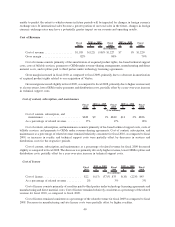Symantec 2010 Annual Report Download - page 120
Download and view the complete annual report
Please find page 120 of the 2010 Symantec annual report below. You can navigate through the pages in the report by either clicking on the pages listed below, or by using the keyword search tool below to find specific information within the annual report.
Interest income decreased during fiscal 2009 and 2008 primarily due to lower average cash balances
outstanding and lower average yields on our invested cash and short-term investment balances. Interest expense
for fiscal 2009, as compared to fiscal 2010, remained relatively consistent. Other income, net for fiscal 2008
includes a net gain from settlements of litigation of approximately $59 million.
Provision for income taxes
2010 2009 2008
Fiscal
($ in millions)
Provision for income taxes ..................................... $112 $183 $213
Effective tax rate on earnings ................................... 13% (3)% 34%
Our effective tax rate was approximately 13%, (3)% and 34% in fiscal 2010, 2009, and 2008, respectively.
The tax expense in fiscal 2010 was significantly reduced by the following benefits recognized in the year:
(1) $78.5 million tax benefit arising from the Veritas v. Commissioner Tax Court decision (see further discussion
below), (2) $11 million tax benefit from the reduction of our valuation allowance for certain deferred tax assets,
(3) $17 million tax benefit from lapses of statutes of limitation, (4) $9 million tax benefit from the conclusion of
U.S. and foreign audits, (5) $7 million tax benefit to adjust taxes provided in prior periods, and (6) $6.5 million tax
benefit from current year discrete events. The change in the valuation allowance follows discussions with Irish
Revenue in the third quarter of fiscal 2010, the result of which accelerates the timing of the use of certain Irish tax
loss carryforwards in the future. The tax expense in fiscal 2009 was materially impacted by the inclusion of a
$56 million tax benefit associated with the $7.0 billion impairment of goodwill in the third quarter of fiscal 2009.
The effective tax rates for all periods presented otherwise reflects the benefits of lower-taxed foreign earnings
and losses from our joint venture with Huawei (“joint venture”) (fiscal 2010 and 2009 only), domestic manufac-
turing incentives, and research and development credits, partially offset by state income taxes.
As a result of the impairment of goodwill in fiscal 2009, we have cumulative pre-tax book losses, as measured
by the current and prior two years. We considered the negative evidence of this cumulative pre-tax book loss
position on our ability to continue to recognize deferred tax assets that are dependent upon future taxable income for
realization. Levels of future taxable income are subject to the various risks and uncertainties discussed in Part I,
Item 1A, Risk Factors, set forth in this annual report. We considered the following as positive evidence: the vast
majority of the goodwill impairment is not deductible for tax purposes and thus will not result in tax losses; we have
a strong, consistent taxpaying history; we have substantial U.S. federal income tax carryback potential; and we have
substantial amounts of scheduled future reversals of taxable temporary differences from our deferred tax liabilities.
We have concluded that this positive evidence outweighs the negative evidence and, thus, that the deferred tax assets
as of April 2, 2010 of $519 million, after application of the valuation allowances, are realizable on a “more likely
than not” basis.
On May 27, 2009, the U.S. Court of Appeals for the Ninth Circuit overturned a 2005 U.S. Tax Court ruling in
Xilinx v. Commissioner, holding that stock-based compensation related R&D must be shared by the participants of a
R&D cost sharing arrangement. The Ninth Circuit held that related parties to such an arrangement must share stock
option costs, notwithstanding the U.S. Tax Court’s finding that unrelated parties in such an arrangement would not
share such costs. Symantec has a similar R&D cost sharing arrangement in place. The Ninth Circuit’s reversal of the
U.S. Tax Court’s decision changed our estimate of stock option related tax benefits previously recognized under the
authoritative guidance on income taxes. As a result of the Ninth Circuit’s ruling, we increased our liability for
unrecognized tax benefits, recording a tax expense of approximately $7 million and a reduction of additional paid-in
capital of approximately $30 million in the first quarter of fiscal 2010. On January 13, 2010, the Ninth Circuit Court
of Appeals withdrew its issued opinion. On March 22, 2010, the Ninth Circuit Court of Appeals issued a revised
decision affirming the decision of the Tax Court. The Ninth Circuit’s decision agreed with the Tax Court’s finding
that related companies are not required to share such costs. As a result of the Ninth Circuit’s revised ruling, we
released the liability established in our first quarter of fiscal 2010, which resulted in a $7 million tax benefit and
increase of additional paid-in capital of approximately $30 million in the fourth quarter of fiscal 2010. For fiscal
2010, there was no net income tax expense impact.
44
























